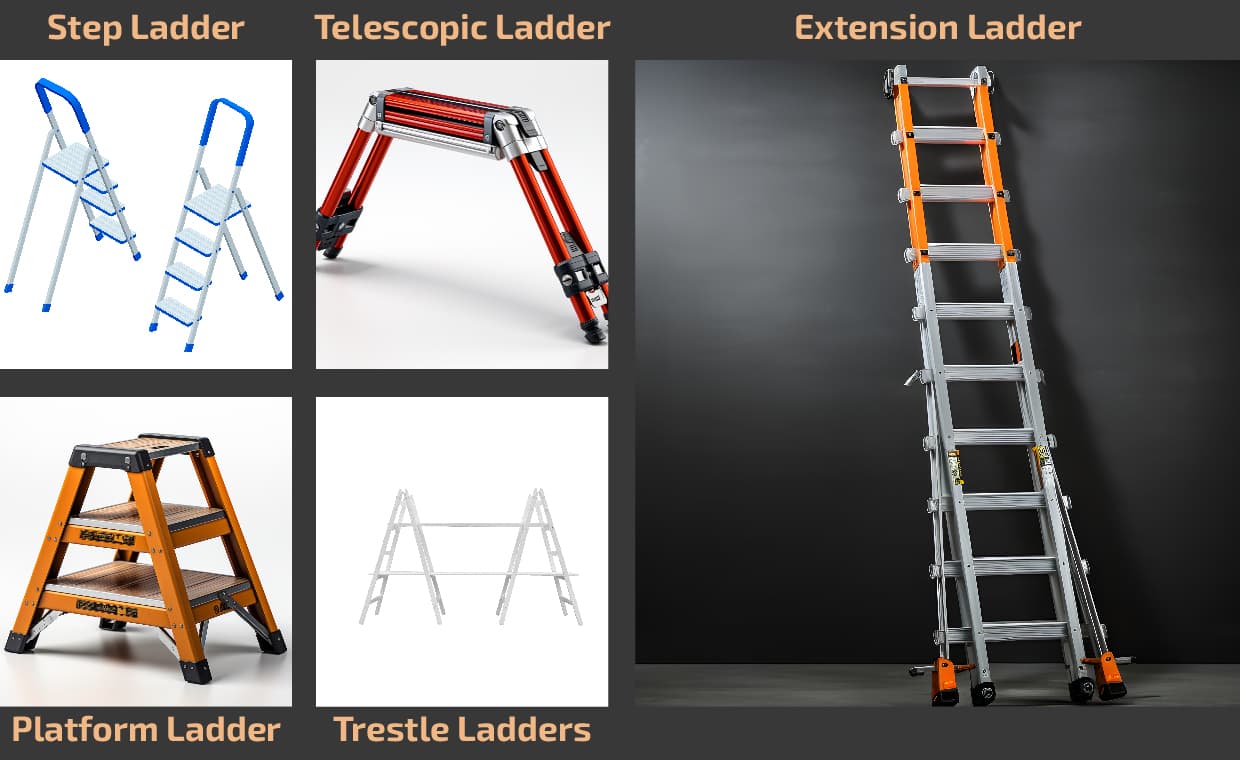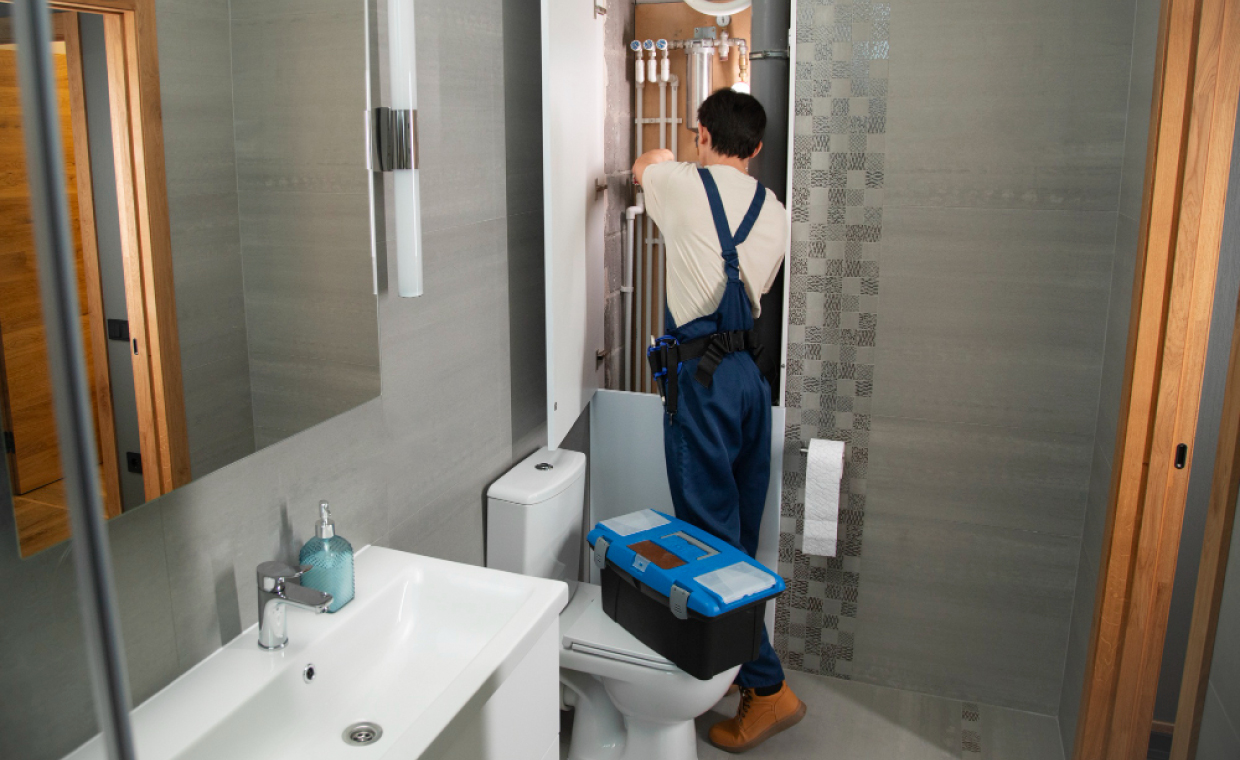
Table of Contents
Ladders are a type of climbing tool consisting of two parallel rods (often made of rope, wood, or metal) with a series of horizontal planks (rungs). Ladders come in different sizes and shapes and help us climb up or down, depending on the task. Knowing the different types of ladders and their uses will help you choose the right one for the job and get it done quicker and safely.
Types of Ladders
The different types of ladders are as follows:
1. Stepladders
2. Straight Ladders
3. Step Stool
4. Platform Ladder
5. Folding Ladders
6. Extension Ladders
7. Trestle Ladders
8. Multipurpose Ladders
9. Attic Access Ladder
10. Telescopic Ladder
11. Warehouse Ladder
01. Stepladders



It is the most commonly used ladder in both residential and commercial settings. This ladder is different from others because one can use it anywhere without any support; even in the middle of a room or in other places where there is nothing to rest it on.
There are two types of stepladders: the front stepladder and the twin stepladder. The steps on one side of the front stepladder are for climbing, while the other side is for support. However, a twin stepladder may have rungs or steps on both sides, allowing you to climb from either side, which is quite beneficial if you require two people to climb simultaneously. When you step on it, the spreaders of this ladder lock in and prevent it from latching. Furthermore, they consist of anti-skid material at their ends to keep them from slipping.
02. Straight Ladders



Straight ladders, also called “single ladders,” are what half-step ladders are. Straight ladders don’t hold themselves up, so they need an anchor at the top. They are portable but don’t have hinges, so they take up less space when not in use. Unlike the straight ladders on wheels you may have seen in libraries, you must climb down a standard straight ladder before you can move it.
A solid wall supports straight ladders, but you can get closer to the wall than a stepladder because they don’t have a supporting side. So, straight ladders are great for cleaning gutters, working on roofs, and doin g construction work.
03. Step Stool



These are small ladders used in kitchens or garages to access not-so-high spots. They are self-supporting and have a front step. Step stools are foldable and hence fit in small areas. The step stool’s main advantages are its convenience and low cost.
04. Platform Ladder

A platform ladder is a type of front-step ladder in which the top rung serves as a platform. Railings are usually put up around the platform to ensure the workers’ safety. With a platform ladder, you won’t have to worry about banging your shins or feet on each rung. If you require both hands for a task or want to turn and work in any direction without hassles, this ladder is for you.
05. Folding Ladders



Folding ladders are easy to store because they are foldable. It is used to get to places like attics and lofts that are high. It’s light and easy to move around. Consider this ladder if you are the type of person who climbs chairs and other unsuitable items to reach high places in your house.
06. Extension Ladders



There are two sections to an extension ladder: the base and the fly. It’s important to remember to keep the ladder’s base (the lowest, major section) firmly planted on the ground. One can extend the ladder’s fly to a custom length or height.
Users must rest it against a wall or other stable object for support. This kind of ladder doesn’t stand on its own. Because of its extendable feature, it is used in jobs that would otherwise necessitate a very tall ladder.
Extension ladders have some safety features, such as hooks, non-slip feet, etc that ensure keeping the ladder in place.
07. Trestle Ladders



Trestle ladders or double-front ladders can hold two people simultaneously. It can be set up on any flat surface and reach higher places. These are great when working in a small space. Trestle ladders are useful for appliance or art installations, painting, or home décor tasks since they allow two people to work in close contact.
08. Multipurpose Ladders



It’s a basic ladder, but it serves many purposes. Some ladders can have up to 24 distinct functions, such as a basic stepladder, an extension ladder, a trestle ladder, and so on. Different settings for this ladder can make it fit to perform many tasks. Folding multipurpose ladders into stepladder configuration makes them self-supporting and safe to use. You may extend them to reach higher areas, but like a conventional ladder, you’ll need robust support. Folding ladders like this are convenient for stowing away because they take up little space when not in use.
09. Attic Access Ladder

If you have an attic or loft in your home, you must own an attic access ladder. They can be basic extension ladders that expand and contract using guided frames. They can also be articulated ladders with hinges to fold or unfold sections of the ladder. Attic ladders are often attached to the attic door and have only one purpose: allowing simple access to small attic openings.
10. Telescopic Ladder



A telescopic ladder is an extension ladder that can be collapsed or extended to a given length. By collapsing all the telescopic beams, the telescopic ladder becomes compact and easy to store. Most telescopic ladders are straight, but others can be bent into twin-step ladders for self-support, and the weight of these ladders is proportional to their height.
11. Warehouse Ladder



A warehouse ladder is a unique kind of ladder suitable for application in a warehouse, industrial, or barn-like setting. The purpose of this type of ladder is to allow the user to easily carry various objects from one area to another, including high places.
A warehouse ladder includes a big platform and railings that provide safety and stability while standing on top. It also contains caster wheels that allow you to move the ladder from one location to another and a solid metal frame.
When choosing the right ladder for a project, understanding the different ladder types, such as stepladders, extension ladders, and multipurpose ladders, is essential.
Types of Ladder Materials
01. Wood



Ladders can be made of various materials, although wood is a typical choice. Wooden ladders are the most cost-effective option compared to metal and plastic ladders. Most house and business owners prefer wooden ladders.
Ladders made of wood can be significantly heavier than other materials. Because of this, they are now far more secure and robust for use in such demanding settings. A wooden ladder can last for decades due to the material’s inherent strength when maintained properly. Wooden ladders are non-conductors of electricity and, hence are safe to use for electrical works.
02. Aluminium



If you need a ladder for simple home repairs, an aluminium one is a great option. Also, from a building perspective, this is the type of ladder that has a lot of potential applications. There are numerous benefits to using an aluminium ladder. They are lighter compared to alternatives made of fibreglass or wood. Hence, even a single person can manage it with great ease.
Aluminium ladders are durable and can withstand rain, snow, and other bad weather conditions. You can keep them outside without worrying about any damage. The price of an aluminium ladder is reasonable.
03. Steel



Steel is the most common material that ladder makers use. They are also the most durable, so most professionals who use ladders for their work choose them. Steel ladders are heavier and last longer than fiberglass and aluminum ladders. This makes them very safe to use, even in warehouses and construction sites, where things can get rough.
04. Fiberglass



Fibreglass might be the best thing to use to make a ladder. Ladders made of fibreglass are the most expensive ones. They are a little heavier than ladders made of other materials, but lighter than steel and wood ladders. Fibreglass ladders are the safest to use because they don’t conduct electricity and are strong, giving you more support even when working on a wet surface.
How to Choose a Ladder for Your Workplace?
Following are some tips on how to choose a ladder:
01. The Proper Ladder Selection

To use a ladder safely, you must get the right one for the job. Each one has things it can’t do. Don’t forget that it’s meant to help with the task, not to make things worse. A stepladder is a cheap option if you want to use it for simple tasks like painting. Most will give you a reach of up to about 14 feet. If you need to conduct outdoor work, consider buying an extension ladder instead of a stepladder.
02. Appropriate Ladder Size

When choosing the appropriate ladder size, prioritising safety is crucial. Generally, you can safely climb up to four feet above the peak, but this does not mean using the top of a stepladder as a stepping point. You should avoid stepping on the top two rungs to maintain stability and safety. Additionally, considering the ladder’s duty rating is essential to prevent it from becoming excessively top-heavy and unstable.
03. Weight of the Ladder

Weight has both positive and negative effects. It gives the ladder stability but makes it difficult to move around. Choosing between the different ladders depends on the material and how you plan to use it. If you are looking for a lightweight option, choose fibreglass ladder.
04. Multipurpose Ladder

A versatile ladder is a great way to get the most out of your money. Even though home models aren’t expensive, having more than one doesn’t make sense when one works on most projects. That is why you should think about how you’ll use the ladder and how long it will last.
Ladder Safety Tips

- When choosing the ladder for the job, it is important to consider the weight of the person climbing the ladder and the weight of the tools, materials, or equipment.
- A ladder can develop problems over time. Look for visual damages periodically.
- A person climbing a ladder should be in good physical condition and capable of doing the duties required. The capacity to grip, walk quickly, get out of a chair, and stand on one’s own two feet are typical indicators of physical fitness. To reduce the number of injuries, employers should provide training on spotting potential ladder risks.
- Stabilise the ladder on a firm, level surface. The ground must be sturdy enough to support the weight of the ladder and its user. Tools like leg levelers, ladder guards, wide boards, and stabilisers can be employed when the terrain is unstable.
- When placing a ladder, be aware of your surroundings. Clear the area around you before using the ladder. Never place a ladder in a driveway or passageway without sound barriers, signs, or assistance.
- Using the ladder unsafely by leaning and extending outward can lead to serious injury or death. To avoid injury, always maintain three points of contact, ensure the ladder is on stable ground, and never overreach.
- It’s important to maintain the three points of contact when using a ladder. When we say “three points of contact,” we’re referring to either two hands and one foot or two feet and one hand.
- Always think about how much weight the ladder can hold. If you try to carry something bigger or heavier than the ladder can handle, it will fall over. The person on the ladder won’t be able to keep three points of contact, which will cause them to fall and hurt themselves.
- You should lean extension ladders at 1:4 angles. For each metre the ladder rises in height, its base must be 4 metres away from the building.
Also Read: 5 Common Causes of Ladder Accidents in Construction Sites
To sum up,
Many types of ladders are available to fit various needs and requirements for homes or workplaces. Most ladders have special features that make them easy and safe to use while helping you accomplish your tasks faster. It is important to pick a ladder that meets users’ needs, considering the work you’ll be doing, the height you need to reach, and the weight capacity you require. However, it is equally important to focus on safety too.
Image Courtesy : Image 9
Author Bio
Sikandar Choudhury– Sikandar Monwar Huda Choudhury is a freelance article writer who is passionate about sharing his knowledge and experience with others through writing. With several years of experience in the engineering field and having written 100+ articles related to construction, Sikandar is a skilled writer with a talent for breaking down complex concepts and making them accessible to a wider audience. Sikandar is always looking for new opportunities to share his knowledge and experience with others through writing and is available for hire as a freelance civil engineering article writer. He is easily reachable on LinkedIn https://www.linkedin.com/in/sikandar-monwar-huda-choudhury-2b3a1a20a/.






























